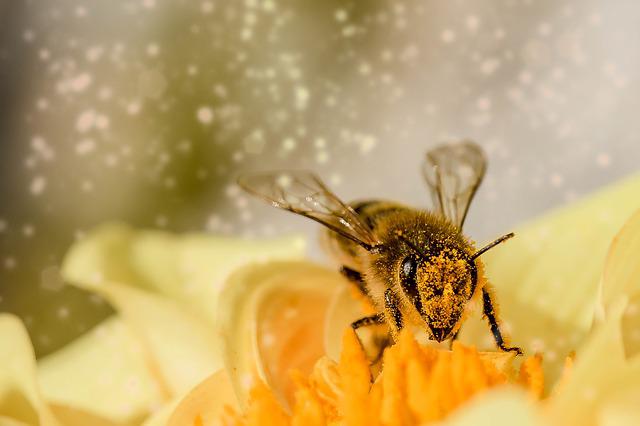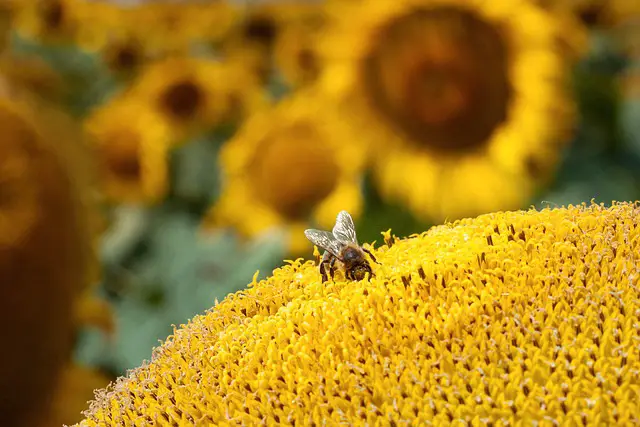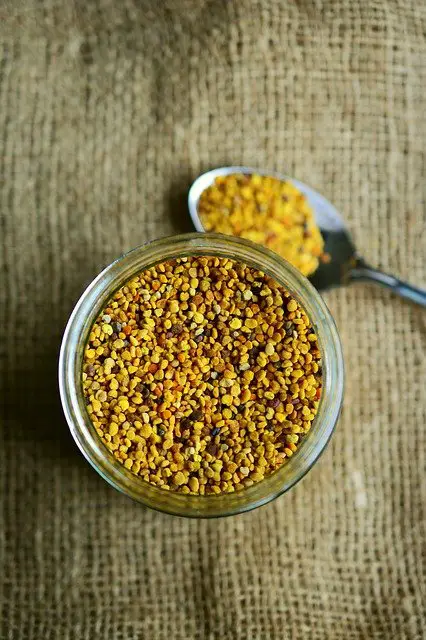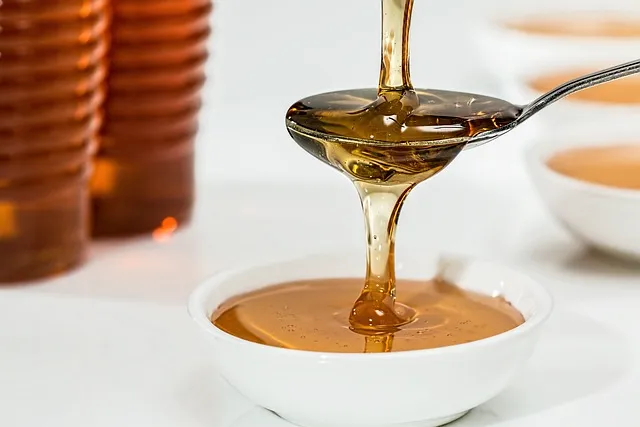Bee Pollen Nutrition Facts
Like honey, bee pollen has been around for centuries, as old as beekeeping. While it is different from bee venom, honey, and propolis, it is still a form of apitherapy (alternative therapy derived from products that come directly from honeybees.
Honey bees use pollen as a raw material to make bee bread for the colony. It is also a food supplement that portrays an array of functions such as antiviral, antifungal, anti-inflammatory, anticancer, and antimicrobial. As such, it has been found to be so beneficial to human health that it is recognized as medicine by the German Federal Board of health.
Similar Articles you may like to read –
How much raw honey per day I can eat? How much Honey is safe to eat?
How much honey to put in a tea?
How much honey should you take for a sore throat? Home Remedy
Why do vegans not eat honey?
Can honey carry disease? honey and disease
What is bee pollen?
Bee pollen is a mixture of plant pollen collected from plant anthers, bee saliva, and nectar. Pollen grains are small, male reproductive elements that form in the anthers of flowering plants. While it provides genetic materials for plant seed development, it also plays a major role in honey bee nutrition.
How do honey bees collect pollen?

Honey bee foragers collect pollen from flowers, plants, and weeds and stack it at the pollen sacs situated at their hind legs. Before storing it in the sacs they mix with enzymes from their saliva and shape it into small balls. They bring the mixture back to the hives and store it in honeycombs, where it undergoes an anaerobic fermentation into bee bread. The lactic acid that results from the process helps preserve the product. The surface of the combs is covered with a thin layer of honey and wax. The bee bread acts as the sole protein source for the bee colony. In addition, it is a source of mineral substances for royal jelly secreted by worker bees to feed the queen and young larvae. The bees store it around the brood stores since it is used to feed the young ones.
What are the different categories of pollen?
The composition of pollen varies depending on the plant source, geographical region, climatic conditions, soil type, and type of bee. Based on the plant origin, they also differ in shape, size, and weight. The grain shapes can either be round, bell-shaped, cylindrical, or thorny while the color of the pollen grains ranges from yellow to black. Most pollens contain single grains, which are joined to two or more grains.
No single floral source produces pollen with all the vitamins, minerals, and proteins with the right ratios for a bee colony. Honey bees tend to forage on various pollen sources to mix up pollen from different species of plants. Pollen sacs delivered to the hive by foragers usually consist of pollen from one plant. A colony pollen collection ranges from 50-250g per day and 1-7 kg annually.
Bee pollen Nutritional Facts
There are about 250 substances in bee pollen, including amino acids, lipids, simple sugars, and vitamins. Other components include carotenoids, phytochemicals, and flavonoids.
Here is an average composition of bee pollen:
- 1.6% phenolic substances
- 1.4% of flavonoids
- 0.1% vitamins( both water and fat-soluble.
- 22.7% of protein5.1% grams of fat
- 16 calories
- 30.8% of carbohydrates
- 1.6% Bio-elements ( calcium, magnesium, sodium, phosphorus, and potassium)
Health Benefits of Pollen

The diverse components of bee pollen are responsible for the many benefits that we enjoy from raw honey.
Here are the potential health benefits of pollen:
Boost Immunity
Bee pollen can enhance the immune response of the spleen as well as stimulate immune organ development.The antimicrobial, antiviral, and antifungal properties help eliminate bacteria such as staphylococcus aureus, which are responsible for food poisoning. It also inhibits allergic reactions.
Promote Wound Healing
This superfood can be used on the skin to speed up healing since it helps to kill bacteria, enhance blood circulation, and moistens the skin. The antimicrobial properties help to prevent infections.
Lower the Risks of Heart Diseases
Antioxidants present in bee pollen may help protect the lipids from oxidizing. Lipids oxidization cause them to clump together, restricting the blood vessels and raising the risk of heart disease.
Boosts Liver Health
The liver helps filter toxins from one’s body, such as drug overdose. Research conducted on rats shows that pollen helps to keep the liver healthy and promotes the healing process once damaged.
An Ideal Dietary Supplement
Bee pollen is an excellent supplement for your diet and health. It is believed to enhance and increase a longer lifespan, increase reproductive success, and improve muscle mass.
Ease the Symptoms of Menopause
Menopause is usually accompanied by hot flushes, sleep disturbances, and mood changes. Research shows that bee pollen may help to reduce some menopausal symptoms. Women who take bee pollen experience fewer hot flushes, enjoy better sleep, and improved mood and energy.
Have Anticancer Properties
Cancer results when cells proliferate abnormally. Bee pollen extracts help inhibit tumor growth and enhance the programmed death of cells.
Minimize Inflammation
Bee pollen contains antioxidants, minerals, and vitamins. As such, it is thought to have remarkable anti-inflammatory properties. According to research, it works by inhibiting the activity of enzymes responsible for the inflammatory processes. Another study conducted on rats with swelling paws showed that it reduced inflammation by 75%. It has been used traditionally to reduce swelling and inflammation.
Improve Nutrient Utilisation
Bee pollen enhances the utilization of nutrients by your body.
Reducing Stress
Taking bee pollen increases the blood flow in the body’s nervous system hence helping to reduce stress as well as reducing tiredness.
Are there dangers of bee pollen contamination?
Honey bees can contaminate pollen with spores, molds, and bacteria; hence is not possible to produce a consistent and clean product from such a contaminated source. While a pollen source may be pure, a bee can contaminate it during collection, storage, and processing. It is highly perishable and must be collected daily and preserved immediately to inhibit mold growth and maintain its nutritional and medicinal properties.
How Beekeepers Collect Pollen?
Beekeepers collect pollen by use of pollen traps. These are devices that fit at the entrance of a hive with openings that are large enough for a returning forager to squeeze through without a load. As they press through the opening, pollen that is carried on the hind legs is scrapped off and falls through the screen, where the beekeeper collects. Pollen traps are usually used in a colony when there is plenty of pollen to collect. When collecting pollen, you should ensure that all the other entrances to the nest are closed off to the returning foragers. Otherwise, the foragers will enter through them to retain their pollen loads.
This process makes pollen production labor-intensive. To avoid potential nutritional stress to a colony, you should put pollen traps for a short period for, a few days. Long-term pollen trapping can negatively affect brood rearing, the adult population, and wax production.
How to Process and Preserve Pollen?
Fresh pollen has a moisture content of 7 -21%, while dried one is about 4%. Its fresh state is prone to spoilage from fungi, bacteria, and molds. It should be preserved immediately after collection to avoid deterioration. You can preserve pollen either through drying, freezing, or refrigeration. The best way to preserve it is through freezing immediately after harvesting. When preserving through drying, it is advisable to dry at a temperature of about 30 degrees centigrade in a dark room.
Drying it in the sun may decrease the product’s potency by up to 50% due to the oxidation of antioxidants. After drying, it should be packed in clean airtight containers. If kept in the open, pollen absorbs moisture from the air and deteriorates. Pure bee pollen for human consumption is usually in granules just as collected from the hive. For human use, the best way to preserve is by drying.
How to Incorporate Bee Pollen in Food
You can add pollen to foods like yogurt, smoothies, milkshakes, and oatmeal. It can also be added to coffee or teas as sweeter instead of table sugar. For toppings on salads, it can be ground into powder or made into granules. You may also find bee pollen in other dietary supplements and skin softening products.
Where can you purchase bee pollen?
Pollen is available in many food stores. Due to its fame as an excellent dietary supplement and the world’s best food product,” it is present in different forms( granules, capsules, tablets, and powders).
Exceptions of Bee Pollen
While bee pollen is an awesome super-food, it makes some people sick! Hay fever, an allergy to wind-borne pollen, is a common condition experienced by quite some people in every region. It is also noted to have a moderate interaction with common blood thinners and can increase the risk of bleeding in patients under blood-thinning medication.
Here are categories of people who should avoid taking bee pollen:
- Patients with existing liver disease
- People who are allergic to other bee products
- Patients with hematological disorders
- Pregnant and lactating mothers. Bee pollen may contain uterine stimulant effects; pregnant mothers should avoid it. Since no evidence currently supports that bee pollen is safe for babies, he mentioned groups should avoid it.
Bee pollen should be taken cautiously since there is a potential to contain mycotoxins.
More articles you may like to read –
How to Determine honey? How To check the purity of honey?
Is honey bee poop or vomit?
Health benefits of eating bee pollen? Is bee pollen good for allergies?
Can you eat honey straight from the hive?
Does honey expire? Can honey be ok after 12 months?
FAQs
Can you get pollen from other foods?
There are no food sources known to contain bee pollen apart from pollen. As it turns out, this is a product that is uniquely made by bees for their colonies as a protein source. The bee secretions transform the pollen into a digestible form for the young bees and humans as well.
What is the recommended dosage of pollen?
The recommended dosage for pollen is 3-5 tablespoons( 20-40g) for adults in a day and 1-2 tablespoons (15g) per day for children. It is also good to seek medical counsel. If you are taking it in capsule form, ensure you follow the instructions on the label to take the right dosage.
What is so unique about bee pollen?
Bee pollen contains more protein than any other animal source and more amino acids than similar weights of beef or eggs. To the amazement of many, bee pollen contains almost all the nutrients that a human body requires to thrive. This superfood is referred to as medicine due to its many health benefits.
You might be interested in our article ” How far do honey bees travel from the hive? “



